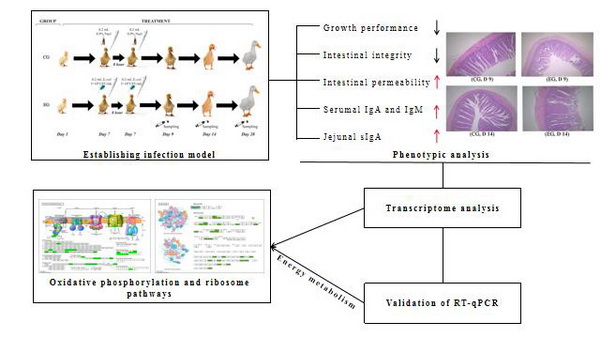A new mechanism of intestinal injury and inflammatory response of meat ducks induced by E. coli
Recently, Feed Resources and Biotransformation innovation research team from the Institute of Feed Research, Chinese Academy of Agricultural Sciences uncovered a molecular mechanism of E . coli O88 inducing intestinal damage and inflammation in meat ducks through oxidative phosphorylation and ribosome pathway, which provides a theoretical basis for effective prevention and treatment of Colibacillosis in meat ducks. The paper was published in Frontiers in Cellular and Infection Microbiology.
Colibacillosis is a common disease caused by pathogenic E. coli infection in meat duck. It not only reduces the growth performance, immunity and surviving rate, but also causes the blockage of the oviduct of breeding ducks and impairs their reproductive performance. Although the pathogenicity of E. coli has been well described, little reports on its molecular mechanisms and therapeutic targets were obtained. In recent years, the research team has continually paid attention to the effects of E. coli on intestinal health of waterfowl and successfully established an E. coli infection model in Pekin ducks and revealed its molecular mechanism. Phenotypic and transcriptomic analysis showed that pathogenic E. coli O88 interfered with the energy metabolism pathway of meat ducks, down-regulated the expression of oxidative phosphorylation and ribosomal related genes, destroyed the integrity of intestinal epithelium, triggered inflammatory reaction, and affected the growth performance of ducks. It has important theoretical and application value for exploring the targets of blocking or treating E. coli infection and promoting the research and development of vaccines or therapeutic interventions.

The research was supported by the Science and Technology Innovation Project of the Chinese Academy of Agricultural Sciences and the National Key Research and Development Program.
More details can be found at the link below: https://doi.org/10.3389/fcimb.2022.940847
By Chang Wenhuan (changwenuan@caas.cn)

